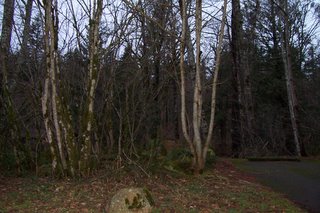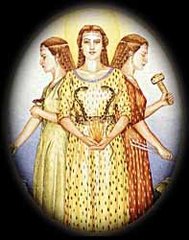If we pay attention to the world around us, we see tiny buds beginning to appear at the ends of tree branches, and new shoots of green grass breaking through the soil. The birds are beginning their mating flights and nest-building. Winter is half over, and they must fly further afield and look harder for food. Other animals are starting to stir from their hibernation, and are hungry too.
 February 2 is Groundhog Day, when Punxsutawney Phil will poke his head out from his underground home to see if his shadow will tell him how much longer winter will last. We already know the answer: spring is still six weeks away.
February 2 is Groundhog Day, when Punxsutawney Phil will poke his head out from his underground home to see if his shadow will tell him how much longer winter will last. We already know the answer: spring is still six weeks away.Our inner journey reflects the season. We too are beginning to stir from our winter hibernation. We begin to ask how long the winter will last within us, while we begin to feel the first stirrings of new life. We start to plan for the coming months, our plans based on whatever we have discovered about ourselves during the winter’s reflections in the darkness.
This season was first celebrated in ancient lands as the lambing season: Oimelc, or Imbolc, meaning “ewe’s milk”. As the winter dragged on, food supplies would run low and the ability to have fresh milk and cheese saved lives.
In Celtic lands, this feast was also known as Là Fhéill Bhrìghde, sacred to the Great Goddess Brighid, who appeared at Imbolc after the Cailleach, the hag of winter, danced upon the snow-topped hills. One of her titles was Brighid nam Brata, or Brighid of the Green Mantle, the green hills of the islands and her power of healing. Fire and Water were sacred to Her. In fact, there was a perpetual flame dedicated to her in Kildare for at least a thousand years, first tended by 19 priestesses in a 20-day rotating cycle, with Brighid Herself tending the flame on the 20th day. The priestesses were eventually replaced by a group of Christian nuns until Henry VIII had the abbey destroyed. The flame was left unlit until 1993 when a group of nuns returned to Kildare and rekindled the flame, where it is again kept perpetually burning. People around the world have since joined a group called Ord Brighideach, and we each take a shift every 20 days to light the flame of Kildare and tend it so that the flame is burning 24 hours a day around the world.
The Goddess Brighid was later transformed into St. Brigid, who was called Mary of the Gaels, midwife to the Virgin, and foster-mother of Jesus. The Christian church took the feast of Imbolc and rededicated it to the Virgin Mary as Candlemas, the celebration of Mary’s purification in the temple 40 days after Christmas.
In many other cultures, such as the Aztec, Iroqois, and the cultures of Asia, this was the time of the New Year celebration, the second new moon after the solstice. Chinese New Year was just a week ago, at the new moon, and we have entered the Year of the Monkey.
It is said that “studying nature is learning divinity”. One way to connect with the earth and its seasons is to take nature walks, learning to identify the plants, animals and birds that are active at different times of the year. Another way is to support environmental causes, adopting wildlife, and participating in beach clean-ups. Growing your own garden is of course another way!
What signs of new life are emerging in nature? How does the energy of the earth feel?
What signs of new life are emerging in you? How does your energy feel?
What can you do to encourage new growth in your life?
What steps can you take now that will help your dreams to quicken?
What can you do to help your connection to the earth grow?
When we respect the earth, the land itself becomes a magic cauldron, full of abundance. The Earth is the Great Mother of all life. The health of the Earth is reflected in the health of our own physical bodies as well.
This is the time to focus our energies on sending healing to the Earth and honoring her gifts to us: water, fire, soil, wind, food, shelter….
Together let us send healing and thanks to the Earth for her gifts.
c. 2004


